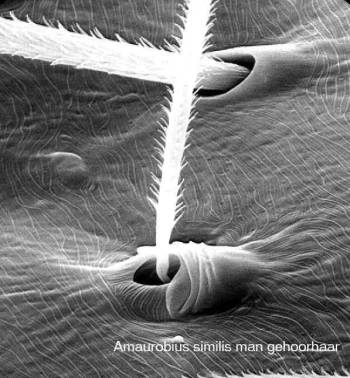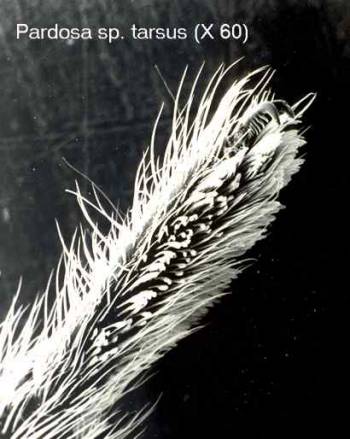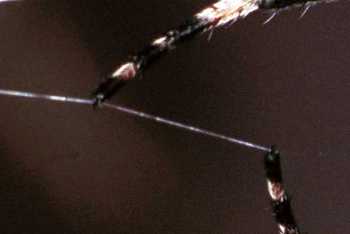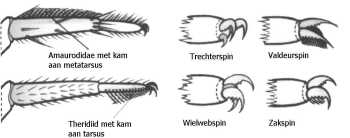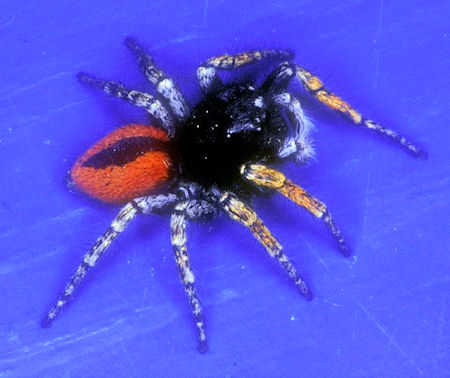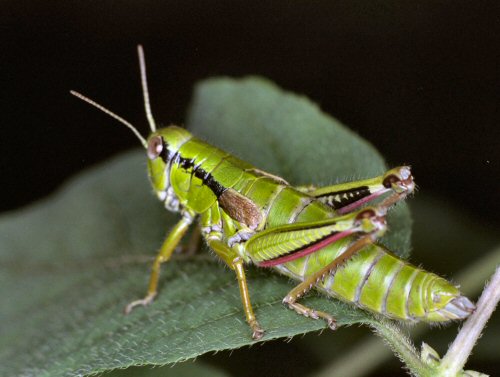The spider
|
The nerve system, sensory organs and legs |
Nervous system and sensory organs
|
|
There are two concentrations of ganglia in the prosoma (head-breast part or cephalothorax) which forms the brain. A number of nerves extends from the brain to the legs, eyes and the rest of the body. The brain takes up a volume of 20 - 30% of the prosoma. Spiders have several sensory organs to get an impression of the surrounding in which they live. A spider does not have ears. Mammals hear with help of hairs that are located in the ear where pressure waves in the air are converted to electric signals. These signals are then sent to the brain and interpreted as sound. A spider hears with very tiny hairs on her legs (thrichobotria). She is very capable of localizing the origin of a sound by interpreting the movement of the air produced by that sound. |
| Hearing hair of Amaurobius similis (bg) |
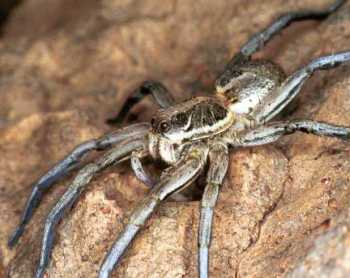 |
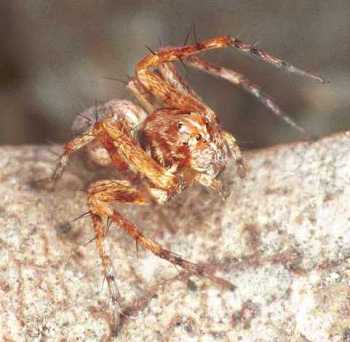 |
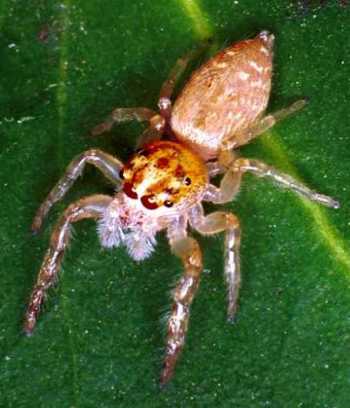 |
| Wolf spider (Lycosidae) | Lynx spider (Oxyopidae) | Jumping spider (Salticidae) |
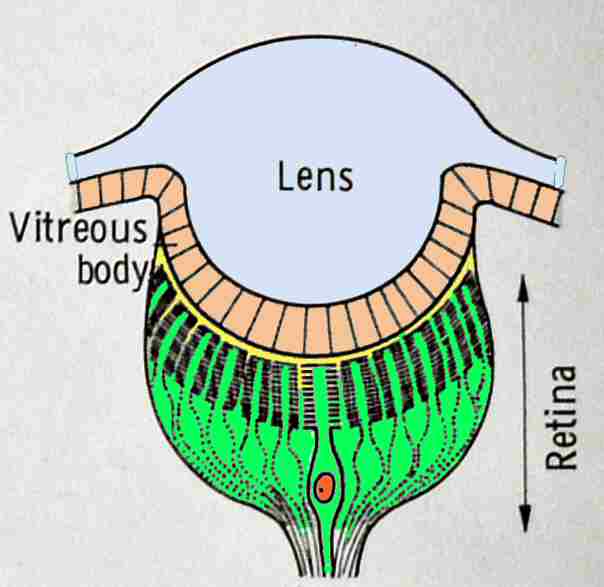 |
The eyes of spider differ greatly
between families. Spiders who hunt without a web like wolf spiders (Lycosidae),
lynx spiders (Oxyopidae) and jumping spiders (Salticidae)
have a well-developed eyesight. Jumping spiders can see nearly as well as
humans. Experiments have shown that they are even capable of seeing
colors. Cave spiders, which live in the dark, have no or hardly any
eyesight. They depend completely on sound and feeling. |
|
Our well-known orb weaving spiders, like the Araneus diadematus, have very small eyes. They do not depend heavily on their eyesight to catch their prey. They have a good developed feeling mechanism that makes them capable of detecting the movements in her web. Spiders detect smell with scent sensitive hairs located on their legs. A sense of taste in their mouth is missing. A spider feels her prey with chemo sensitive hairs on her legs and senses if the prey is consumable. |
 |
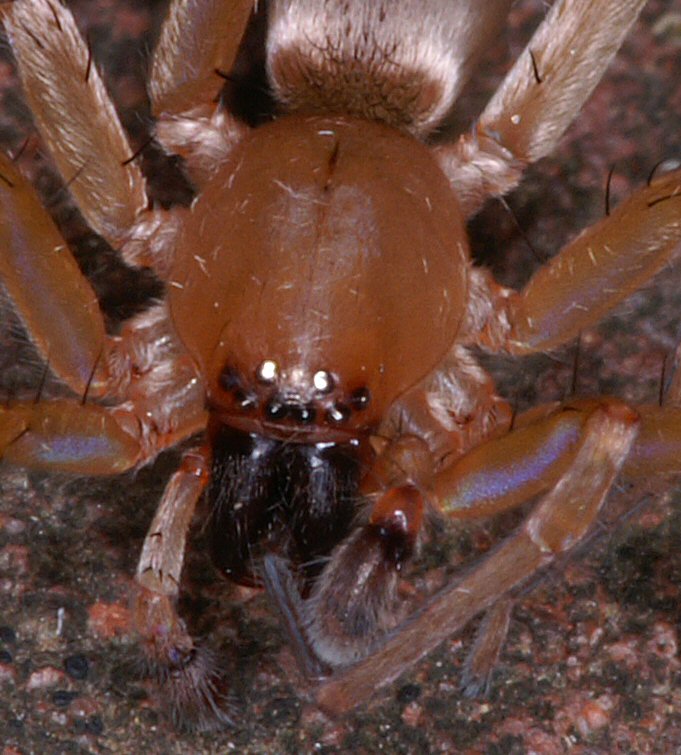 |
| Tiny eyes of Araneus diadematus | Reflecting eyes of Clubiona stagnatilis caused by the flashlight | |
The legs
| Beside the above-mentioned hairs on the
legs, spiders have more features worth studying. The legs consist of seven
segments.
Who has never found a
house spider crawling in the sink incapable of getting out? But jumping
spiders are never found in the same sink. |
|
|
| Leg end of Eresus. He can not climb out of a sink | Tiny hairs on the tarsi of Pardosa sp. (bg) |
For example, there are thousands of fine hairs on the tarsi of the wolf spider. Every hair sticks to the smooth surface of thin water surface (adhesion). This adhesion to water is the secret of walking/climbing over smooth surfaces, which has been shown by experiments. In this experiment a part of the smooth surface was treated with a water-removing chemical. As a result spider fell off the treated area. When the water film was restored the spider was again able to climb the surface. |
|
|
|
|
| Claws of the orb web spider Larinioides sclopetarius |
Legs ends of some spiders |
Orb weaving spiders have claws on their tarsi. This is the reason they cannot climb on smooth surfaces but are very capable of hanging on threads. The spider grabs a thread with its middle claw and squeezes the middle claw against serrated bristles, situated opposite the claw. This gives a firm grip. To release the thread the claw is elevated and the bristles push back the thread. The elasticity of the thread also causes it to spring back out of the clasp of the claw. And why does the spider not stick to its own web? The answer is simple; the spider avoids walking on the sticky lines and when it touches a sticky line by accident the contact area is too small to stick permanently. The movement of the legs of a spider is partly hydraulic, partly by muscles. The spider stretches its legs by raising the blood pressure in the legs. A jumping spider can create a force that makes her capable of jumping 25 times her length. This hydraulic system works excellently and can be seen if we compare the legs of a grasshopper to those of a spider. The grasshopper has two gigantic legs with a lot of muscles packed in it. Looking at the jumping spider one cannot detect these extra muscles. |
|
|
|
|
| The legs of the jumping spider, Philaeus chrysops in comparison with the legs of the grasshopper Miramella alpina |
|
Next: Web and silk
Home <------
Ed Nieuwenhuys, 23 march 2023
December 2011 ,17 jan 201, 23 March 2008, 16
november 2006, January 2006, January 1999
